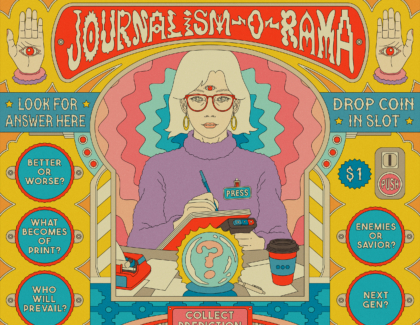Sign up for the daily CJR newsletter.
Last week, Handelsblatt, a German business daily, dropped a bombshell story that detonated with particular force in the United Kingdom. Citing unnamed sources, the paper reported that senior German officials believed the coronavirus vaccine developed by AstraZeneca—which Britain is racing to pump into the arms of its oldest residents—to be only 8 percent effective among people over the age of sixty-five, and expected the European Union’s medicines regulator to publicly support that assessment. British officials reacted furiously—one accused Handelsblatt of spreading Russian-style disinformation—and AstraZeneca immediately dismissed the story as “completely incorrect.” The next day, Germany’s health ministry said in a statement that there appeared to have been a mix-up: the 8 percent figure, it said, had nothing to do with efficacy, and likely referred instead to the proportion of participants in an older age group in AstraZeneca’s trial. British media Twitter blew up; there was a measure of schadenfreude, and there were memes. (“Thrilled to have started today in Handelsblatt’s legal department,” one read. “Now for a cup of coffee and to check Twitter!”)
The Handelsblatt story dropped in the middle of a broader post-Brexit vaccine row between the EU and Britain. (To oversimplify: AstraZeneca fudged a vaccine commitment to the EU due to a production issue; the EU responded by claiming contractual entitlement to AstraZeneca vaccines made in Britain; Britain disagreed; the EU threatened, explosively, to control the export of Pfizer vaccines to Britain, then backed down.) As the week wore on, more European officials publicly trashed the AstraZeneca vaccine; on Friday, Emmanuel Macron, the French president, told reporters that it appears to be “quasi-ineffective on people older than 65, some say those 60 years or older.” The Oxford academic who oversaw the development of the vaccine accused Macron of trying to “reduce demand” to ameliorate the supply issue; a British official told Politico that Macron’s comment would “get a crank banned from YouTube.” Later on Friday, the EU’s medicines regulator recommended that the vaccine be authorized for people of all ages; it pointed to a lack of adequate trial data on older people, but said that “protection is expected.” Germany’s public health agency said that it could not recommend the vaccine for older people—but it, too, cited a lack of data, not Handelsblatt’s 8 percent figure. (Following the initial controversy, Handelsblatt stood by its story; its lead reporter, Gregor Waschinski, complained on Twitter that some of its critics likely hadn’t read it, adding “no hard feelings, German is no fun language to learn.” A spokesperson for Handelsblatt did not reply to my requests for comment.)
ICYMI: Myanmar’s embattled press faces a military coup
Regardless of the story’s accuracy, various journalists criticized Handelsblatt for its anonymous sourcing and lack of data, given the sensitivity of the subject matter. “The virus is not a political story suited to the palace intrigue of political journalism, with its briefings and counter-briefings,” the New Statesman’s Ido Vock wrote. “Muddying the waters by throwing around incendiary claims runs the risk of damaging public trust not just in the AstraZeneca vaccine but in the global vaccine effort as a whole.” Debates about vaccine coverage are not limited to Europe, either—as the story has become an urgent worldwide concern, attracting mass interest and roping in legions of reporters who don’t typically write about science or medicine, experts and media-watchers have pointed to framing errors that keep recurring. As my colleague Shinhee Kang reported in November, the vaccine-development story was marked, among other trends, by sports-match style commentary and by sensationalized reactions to supposed safety incidents. Now that the story has entered a new phase—mass distribution, with its attendant political and logistical messiness—those problems are still apparent, and we’re confronting new ones all the time.
In recent weeks, some experts have criticized news organizations (and other experts) for overly negative coverage of the vaccines currently in use; they are highly effective and constitute a remarkable scientific achievement, the argument goes, and yet, as the Harvard epidemiologist Julia Marcus wrote in The Atlantic, many stories “belabor their imperfections”—the protection they offer not being immediate, the possibility that vaccinated people can still spread the virus, and so on—and risk giving the “misimpression” that the vaccines don’t offer much benefit. “We are dramatically underselling the amazing vaccines, exaggerating the uncertainties and people trying to emphasize the good news are being drowned out, or worse,” Zeynep Tufekci, the sociologist and frequent commentator on the pandemic, tweeted recently. Some experts and science journalists have pushed back on such assessments, arguing, among other points, that clear and prominent communication about vaccines’ weaknesses and uncertainties is crucial in combating anti-vax propaganda. The overall effect, from consuming coverage, is whiplash, or something like it. Ellen Ruppel Shell, a professor of science journalism at Boston University, told me yesterday that vaccine framing can be “schizophrenic—alarmism followed by sometimes misleading reassurance.” This is true, for example, of many stories warning about vaccines’ possible reduced efficacy against new variants of the virus, whose scary headlines often belie more nuanced expert assessments and key questions that have yet to be answered. “There are going to be many, many variants,” Shell said. “I’m not sure how useful it is for the press to run down each one and ask the eternal question: How bad is this? Tell us right now.”
Another key theme in coverage of the vaccine rollout—especially in the US—has been equity. Here, too, there are problems, though they aren’t exclusively the fault of journalists; as Rachana Pradhan and Fred Schulte wrote for Kaiser Health News last week, US health officials “are struggling to collect critically important information—such as race, ethnicity and occupation—of every person they jab,” making it hard to know, for example, whether well-connected people are jumping in line ahead of frontline medical workers. Data that the federal government published this week omitted race and ethnicity information on nearly half of all vaccine recipients so far—a crucial gap in our knowledge, since the data for the other half of recipients showed disproportionately low vaccine access among Black and Latinx people. “The news about racial disparities in vaccine access is continuous, jarring, and stark,” Roxanne Khamsi, a freelance science writer and editor, told me recently. “It’s getting coverage, but we journalists need to shift from just reporting on the trends to doing accountability journalism and pointing to the racist policies that need to be fixed.” Vaccine equity, of course, also has a geographic component, both between US regions and internationally; as richer countries fight for vaccine doses (see above), poorer countries are missing out. As I wrote in December, this situation is both immoral and inimical to richer countries’ self-interest. It is getting a lot of coverage, but again, there could be more of it, and it could be sharper.
It’s hard to generalize, obviously, but it’s increasingly clear that much vaccine coverage is stuck in conventional journalistic rhythms that don’t serve the story well. Given that the pandemic is a “once-in-a-hundred-years event, it’s time for journalists to step back and think about what our priorities need to be,” Shell told me. “We don’t just take notes and put them out there. Almost every piece should have some analysis in it.” In the course of this reflection, we need to reckon, too, with the idea that vaccines may not be a magic bullet. Elena Conis, a science historian and journalism professor at Berkeley, told me yesterday that her biggest concern with vaccine framing is that “we have rushed to cover, talk, and think about vaccination all while failing to have much harder conversations about other things we can do to keep this epidemic in check.”
Below, more on vaccines:
- A lifeline: Last month, CNN’s Kerry Flynn spoke with local reporters—at the Kansas City Star, the Arizona Republic, the Biloxi Sun Herald, and elsewhere—who have been inundated with questions from readers who have questions about the vaccine rollout and haven’t been able to get answers from official channels. Several reporters told Flynn that the engagement on their vaccine stories “has been shocking” and that their “focus on service journalism has been good for business, though it has contributed to a drop in attention on investigations.” Elsewhere, Poynter and the Washington Post both have profiles of CD Davidson-Hiers, a reporter at the Tallahassee Democrat who has become an “unofficial vaccine hotline” for seniors.
- Misinformation: Yesterday, First Draft, a nonprofit that works on countering harmful misinformation, launched a new Vaccine Insights hub, a resource allowing journalists and researchers to monitor the latest trends in vaccine news and misinformation online—including which communities are being targeted, and details of text and email scams—as well as data on vaccine hesitancy. First Draft is also running workshops on best practices for combatting vaccine misinformation; you can find more details on the hub here.
- Who owns the vaccines? Last week, On the Media’s Brooke Gladstone spoke with Dean Baker, a senior economist at the Center for Economic and Policy Research, about vaccine supply issues in the US and the intellectual-property framework within which they are occurring. Vaccine developers “own a patent, and what that means is that no one else could produce them without getting a license,” Baker said. “Patents are a form of monopoly. Unless we change the policy, there’s not much we could do about that.”
Other notable stories:
- According to the Daily Beast’s Maxwell Tani, President Biden’s communications team has been asking reporters what questions they plan to put to Jen Psaki, the press secretary, ahead of her briefings. The White House says that it is just trying to get reporters the information they need, but some correspondents are annoyed; one told Tani that “the press can’t really do its job in the briefing room if the White House is picking and choosing the questions they want.” (So far, Psaki has called on every reporter present at each of her briefings.) The practice has driven debate online. Erik Wemple, media critic at the Washington Post, argued that we should reconceive the briefing as “a place where reporters get answers for stories they are working on and not a theater for scoring points.”
- Kevin Roose, a tech columnist at the New York Times, asked experts how the Biden administration could help fix America’s broken information ecosystem. Their suggestions included: getting a handle on the scope of domestic extremism, including by setting up a “truth commission” to investigate the insurrection of January 6; tapping a “reality czar” to coordinate an interagency response to disinformation; demanding that social media platforms be more transparent with their algorithms; and, crucially, “making reality worth coming back to.” (On Monday, I rounded up some possible nongovernmental fixes in this newsletter.)
- As shares in GameStop started to plunge this week, Recode’s Peter Kafka asked Henry Blodget, the former Wall Street analyst who now leads the media company Insider, whether the press irresponsibly stoked the frenzy that hiked GameStop’s share price. Blodget noted two contradictory truths: “When speculative frenzies are inflating, people mostly want to hear about how to play,” and “the moment the music stops, people start looking for others to blame,” including the media. (In other Blodget news, his site Business Insider is dropping “Business” from its name in a bid to expand its brand.)
- Jeff Bezos said yesterday that he will soon step down as CEO of Amazon. Andy Jassy, who runs the company’s cloud computing division, will replace him; Bezos will become executive chair, a role he says will give him more time to focus on outside commitments, including his ownership of the Post. (As CNN’s Brian Fung noted, not many people can say “I’m quitting to spend more time with my newspaper and space rockets.”)
- Marty Baron, the Post’s outgoing editor, gave an exit interview to Matthew Kassel, of Jewish Insider; among other things, Baron said he receives more anti-Semitic abuse now than he did in the past and reflected on criticism of his paper’s coverage of the Middle East. “You can go back hundreds of years—thousands of years—and people want to have all that context in a thousand-word story,” he said. “It’s just not possible.”
- The American Spectator, a conservative digital magazine, is suing The Spectator, a conservative British magazine that launched a US edition in 2018, for trademark infringement. Sara Fischer, of Axios, reports that the two publications have traditionally had an amicable relationship; a spokesperson for The Spectator said it discussed its US launch plans with the American Spectator and was “surprised” when the latter filed suit.
- A court in Russia sentenced Alexei Navalny, the country’s jailed opposition leader, to a further two years and eight months in prison, ostensibly for violating a parole deal. Navalny used the hearing to denounce the process as a “show trial” and President Putin as “Vladimir the poisoner”; after the verdict, his supporters marched in Moscow and Saint Petersburg, and more than a thousand people were arrested. Meduza has more.
- In 2018, after a UN report condemned Myanmar’s military for persecuting the country’s Muslim Rohingya population, Facebook removed pages tied to the military, including that of its media outlet, Myawaddy TV. This week, following a military coup in Myanmar, the Wall Street Journal’s Newley Purnell flagged to Facebook that Myawaddy’s page had reappeared; Facebook took it down again. The platform is also cracking down on pro-coup posts.
- And things went downhill quickly yesterday after Newsmax invited Mike Lindell, the pillow impresario and Trump booster, on air to talk about “cancel culture.” Lindell instead started pushing conspiracy theories about Dominion, a voting-tech company that has threatened to sue Newsmax over its election coverage; host Bob Sellers interrupted Lindell and read a disclaimer, before walking off the set altogether. Here’s the video.
ICYMI: The Courts Beat
Has America ever needed a media defender more than now? Help us by joining CJR today.







